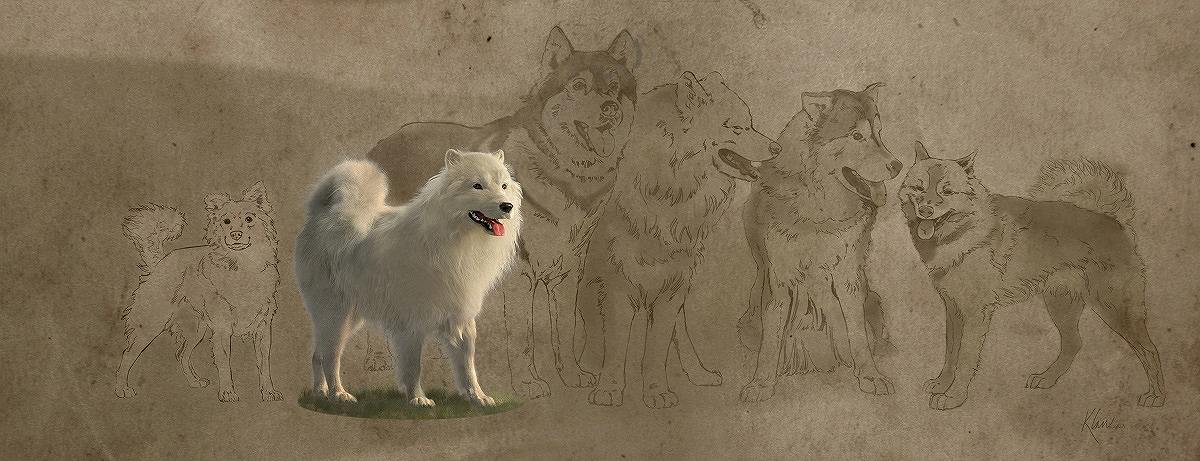
A full-body reconstruction of Mutton shows how the woolly dog would have stood alongside Arctic dogs and spitz breeds.
17:17 JST, December 15, 2023
Ancient DNA from the pelt of a fluffy white dog named Mutton is revealing new details about the woolly dog, an extinct breed that was cared for and raised by the women of the Coast Salish tribal nations in the Pacific Northwest. The small dogs – called “sqwemá:y,” “ske’-ha” and “sqwbaý” in some Coast Salish languages – were fed a special diet of fish or elk, and they were shorn like sheep, their wool woven into special blankets and textiles.
For thousands of years, woolly dogs were cherished as family members and raised on islands or kept in pens to ensure they didn’t interbreed with other dogs, according to Michael Pavel, an elder of the Skokomish-Twana tribe and one of the authors of the study, published Thursday in the journal Science. The last woolly dogs disappeared around the end of the 19th century, but they have been kept alive in stories passed down by Coast Salish elders.
The new analysis of DNA from Mutton’s pelt, which is housed at the Smithsonian Institution, confirms the traditional knowledge of Coast Salish people.
Woolly dogs split from other dogs in North America somewhere between 1,900 and 4,800 years ago, the data show. Mutton had only 16 percent ancestry from European dogs – a tiny contribution that, to researchers who study ancient dog DNA, signifies the care with which they were raised even decades after European settlers arrived.
“It’s not just a dog – it’s a relative. It has enormous spiritual power, conveyed in its wool,” Pavel said. “Imagine being able to receive the gift of wool fiber, being able to learn to weave that into yarn, into an entity, or a blanket or robe that you could wrap yourself in the coldest of winter, and feel the warmth of those prayers. That’s how we look at it, and we can now enjoy a scientific view, as well.”
The DNA evidence, combined with the oral history from Coast Salish elders, also makes it clear that the prevailing explanation for the decline of dog-wool weaving fails to grapple with the dark role of colonialism. The commonly offered explanation is that machine-woven blankets were more convenient and replaced ones made by hand. But the study authors note that the people who cared for woolly dogs were decimated by diseases brought by colonizers, and Coast Salish elders shared stories of active efforts to extinguish cultural identity and authority among the survivors.
“They were told they couldn’t do their cultural things. There was the police, the Indian agent and the priests. The dogs were not allowed,” Rena Point Bolton, a 95-year-old elder from the Stó:lō Nation, told the researchers in an interview. The traditional tools that weavers used to turn wool into yarn, shxwqáqelets, were also not allowed.
A very good boy called Mutton
In the mid-19th century, George Gibbs, a naturalist and ethnographer working for the Northwest Boundary Survey for the U.S. government, adopted a woolly dog named Mutton.
Little is known about Mutton’s life, but in August 1859, a naturalist working with Gibbs in southwest British Columbia wrote to a curator at the Smithsonian Institution that Gibbs’s dog, who had recently been sheared, had eaten the head off a goat skin they had collected.
When Mutton died later that year, his pelt was collected, with a tag noting: “Mr G[ibbs]’s dog ‘Mutton’ Chiloweyuck Indians.” Researchers aren’t sure exactly where Mutton was from, but they note that he could have come from a Coast Salish community near the present-day town of Chilliwack, which sits on the Fraser River, east of Vancouver, on the lands of the Stó:lō Nation.
The longhair pelt was rediscovered within the Smithsonian’s collection in the early 2000s. Audrey Lin, an evolutionary molecular biologist then at the Smithsonian’s National Museum of Natural History with a keen interest in ancient dog DNA, learned of it during the pandemic and hoped to study it.
Studies show that dogs arrived in the Americas alongside people, around 15,000 years ago. But they vanished. Today, there are only the faintest genetic traces of these pre-colonial dogs in modern-day dogs, and Lin wanted to know why and how they went extinct.
Mutton’s pelt gave researchers a way to use modern tools to probe the dog’s ancestry during this pivotal time, so Lin and colleagues approached Coast Salish leaders to find out whether research into the woolly dog would be welcomed.
Steven Point, a grand chief of the Stó:lō Nation, had long heard stories about the woolly dog. His mother, Rena Point Bolton, remembers her grandmother telling stories of raising the woolly dogs to weave blankets. When he learned that there was a pelt of a woolly dog, he was astonished.
“This was like a miracle, something from our past that was all of a sudden discovered,” Point said. “You sit by your grandparents’ side, and you hear these stories. . . . To find someone, somehow has got one of these dogs – what a happy moment that was. It’s kind of like a confirmation that everything the elders told you was true.”
Researchers sequenced Mutton’s genome and compared his DNA to that of a non-woolly village dog from the same region that died around the same time, along with other modern and ancient North American dogs.
They first examined Mutton’s mitochondrial genome, DNA that is passed down from maternal ancestors. His closest relative was a 1,500-year-old dog from Prince Rupert Harbour in British Columbia. When looking at the rest of his DNA, Mutton was 84 percent precolonial Indigenous dog, with only a small portion of European ancestry.
“We interpret the fact there is that much pre-contact ancestry, that late in time, as really underscoring the care with which people were caring for these dogs, to keep them reproductively isolated,” said Logan Kistler, a Smithsonian anthropologist.
Kelsey Witt Dillon, a population geneticist at Clemson University who was not involved in the study, agreed.
“It’s easy to assume the dogs running around the Americas thousands of years ago all looked the same and were generic-looking, and people were interacting with them but weren’t managing them in they way they do today,” Witt Dillon said. “In some parts of the Americas, people were doing a lot to cultivate specific traits in their dogs.”
Elinor Karlsson, a scientist who studies dog DNA at the University of Massachusetts Chan Medical School and the Broad Institute, said that the paper weaves together the fields of ancient DNA and anthropology, showing “the degree to which Europeans overwrote the history of these people and the preconceptions about their cultures not having the complexity they obviously had.”
Reclaiming dog-wool weaving
The first European explorers arrived in the Coast Salish region in the late 18th century, bringing not only their own machine-made blankets, but also smallpox and other diseases. Epidemics are estimated to have killed more than 90 percent of Indigenous people in villages across British Columbia. In 1858, more than 33,000 miners arrived during the Fraser River gold rush, adding to the pressure.
It’s unclear what exactly happened to the woolly dogs. But they would have lost many of the caretakers who assiduously maintained the breed. And active efforts were made to rob people of their cultural identity and sense of power.
“So enduring was the dog, it became obvious, as I was told, how important the dog was to maintaining our traditions, our culture – to maintaining our traditional knowledge. And in the scheme of colonization and genocide, that couldn’t happen,” Pavel said.
The Smithsonian researchers hope to bring Mutton to the Coast Salish region, where the people are now reclaiming many of those traditions.
Debra Sparrow, a self-taught weaver of the Musqueam Nation, said that it was only when she began to learn weaving that her grandfather, who was born in 1898, told her about the woolly dog and described how wool would be made by combining dog hair, mountain goat wool and fibers from stinging nettle.
“I said, ‘Why didn’t you tell me?’ and he said, ‘You didn’t ask,'” Sparrow said. “The assimilation process had done its job well. . . . They were told by the residential school: You’re not allowed to do anything that allows you to identify with your past.”
In the new year, she is starting on her most ambitious project yet: She will weave a dog-wool blanket using all the old methods she learned from her grandfather. She’ll create dyes from lichens and mushrooms. She’ll have to substitute a different dog’s hair, possibly a husky, to substitute for the woolly dog.
“For the first time in my entire life, I’m nervous,” Sparrow said. “I’m finally ready to challenge and connect to my ancestors, and say, ‘Let’s do this.'”

The pelt of a Coast Salish woolly dog named Mutton, who died in 1859, is housed in the Smithsonian collections.
"News Services" POPULAR ARTICLE
-

American Playwright Jeremy O. Harris Arrested in Japan on Alleged Drug Smuggling
-

Japan’s Nikkei Stock Average as JGB Yields, Yen Rise on Rate-Hike Bets
-

Japan’s Nikkei Stock Average Licks Wounds after Selloff Sparked by BOJ Hike Bets (UPDATE 1)
-

Japanese Bond Yields Zoom, Stocks Slide as Rate Hike Looms
-

Japan’s Nikkei Stock Average Buoyed by Stable Yen; SoftBank’s Slide Caps Gains (UPDATE 1)
JN ACCESS RANKING
-

Keidanren Chairman Yoshinobu Tsutsui Visits Kashiwazaki-Kariwa Nuclear Power Plant; Inspects New Emergency Safety System
-

Imports of Rare Earths from China Facing Delays, May Be Caused by Deterioration of Japan-China Relations
-

University of Tokyo Professor Discusses Japanese Economic Security in Interview Ahead of Forum
-

Japan Pulls out of Vietnam Nuclear Project, Complicating Hanoi’s Power Plans
-

Govt Aims to Expand NISA Program Lineup, Abolish Age Restriction



























